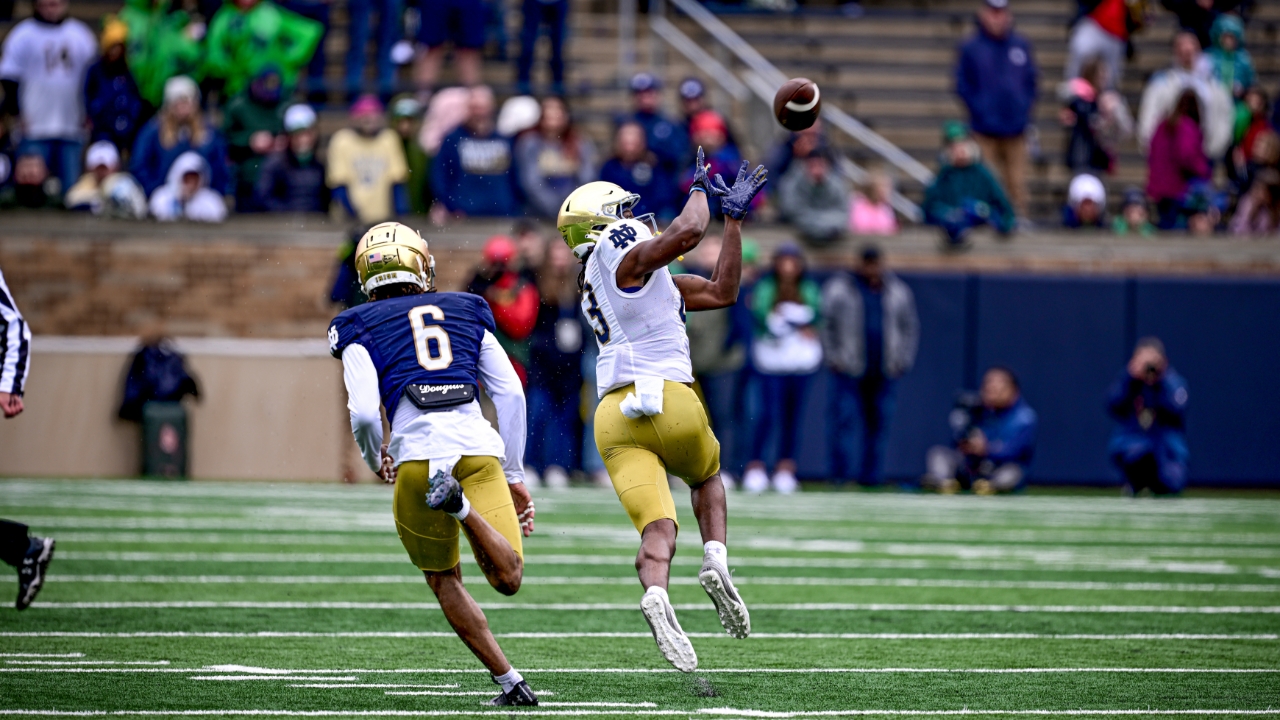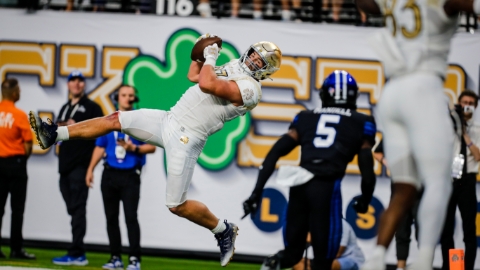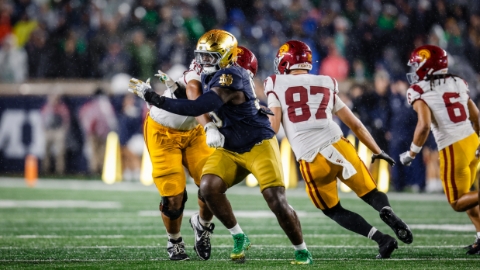
People love predictions.
They want to know how many yards passing, rushing, or receiving. They want over/unders on sacks, touchdowns, and, most importantly, wins. They want to know all of that because then they can envision how a season is going to turn out.
The truth is that no one knows. We make educated guesses, but injuries happen, blowouts happen, and bad games happen. And there are always surprises.
Rather than focus on predictions, I’m turning my attention toward some numbers I’ll be tracking this season for Notre Dame. These numbers matter, even if they are rarely ever mentioned on a telecast or in a post-game story.
These stats are mostly focused on individuals, but the first one is about the defense as a whole. The main thing I’m monitoring is negative plays on defense, the pass rush, and big plays from Notre Dame’s wide receivers.
Add them together and they’re all important in determining how good the 2023 Fighting Irish can be.
(For a quick advanced stats explainer, check out this board post here)
Havoc rate
Havoc Rate is essentially negative plays created by the defense (tackle for loss, pass breakup, interception, or forced fumble) divided by the number of total plays against.
Why does it matter? Other than the fact that those negative plays can swing momentum in a game, teams who play at a championship-level generally have defenses that create a lot of havoc. Seven of the last nine national champions had a defense that produced a Havoc rate of 19.5% or higher.
Notre Dame’s defense has only achieved that rate once in the last six seasons. They were at 20.8% in 2020. The rates in 2018 and 2019 were 17.4% and 18.4%. 18.4% is a top-25 level, but they want closer to top-10 to 15.
Marcus Freeman’s last defense at Cincinnati had a Havoc rate of 19.4%.
Playing a bend, but don’t break style of defense isn't the correct approach these days. Notre Dame’s 2012 defense was great, but a 15.3% rate matches what the Irish did on defense last season, which shows how much the game has changed.
That was a disappointing number. The positive heading into this season is that they had a Havoc rate of 17.8% in the final six games of 2022, so they were heading in the right direction.
I think they’ll create more havoc this fall by being more aggressive with some sub-packages, having a better pass rush across the board, and having very good to great cornerback play.
Can they get to 19.5% or above? I think it’s possible with the personnel they have.
How many finish with double digit Havoc plays?
If the rate is going to be high, it means a defense has to have a lot of playmakers. They had that in 2018 with nine posting double digit total havoc plays. They were just missing those one or two players who put up game wrecker numbers like the 2020 defense had in Butkus Award winner Jeremiah Owusu-Koramoah.
The Irish defense only had three players who put up double digit havoc plays in 2022. Isaiah Foskey had 15, JD Bertrand had 11.5, and Ben Morrison had 11.
It’s safe to pencil in both Bertrand and Morrison for double digits this season. Cam Hart had 14 in 2021 and Jack Kiser had 10. If Hart’s healthy, he can have that kind of impact again this fall. For Kiser, it might depend on how many snaps he plays. He played 60 less in 2022 and with a bit of a log jam at Will linebacker and it being unknown how much Notre Dame will play in base with a Rover on the field, it might be tough for him to get there this fall.
Xavier Watts’ role increased in the final third of the season and so did his playmaking (four havoc plays in final four games). Jordan Botelho had 6.5 and he didn’t become a consistent player in the rotation until the Syracuse game. It would be very surprising if he didn’t make a lot of plays as Notre Dame’s starting Vyper in 2023.
Thomas Harper is the projected nickel corner for the Irish and he had 4.5 in seven games at Oklahoma State last season. Javontate Jean-Baptiste had five in 251 snaps last season for Ohio State.
Clarence Lewis has 24 in his career. Rylie Mills had six tackles for loss last season and looks poised to finally have that breakout season this fall.
There’s a host of young defenders who could also emerge as game wreckers at some point. Notre Dame doesn’t lack candidates.
It would be shocking if they ended up with only three at the conclusion of this season.
How many players with over a 20% TPS win rate?
TPS means true pass sets. It’s used to evaluate linemen in pass protection or defensive linemen rushing the passer on a pass with no play action, no screen, no rollout, no quick game (time to throw between two and four seconds), and with more than a three-man rush.
It gives a better picture of a pass rusher/protector because a team might throw it 50 times in a game, but if large chunk are screens/quick game, those aren't losses if a defensive linemen doesn't get pressure.
So, why 20% as the cut off? Because it’s truly a rare thing to have more than one or two defensive linemen over that mark on a single team.
Last season there were only 64 Power 5 defensive linemen who were above that mark. Foskey has more sacks than any Notre Dame player since they started recording it as a stat. He never got over 20% (18.6 in ‘23)
The only player who was over 20% for the Irish last season was Botelho and he only had 27 pass rush opportunities on true pass sets, but one of the big reasons to be optimistic about his potential this season is that he pressured the quarterback on 30.8% of those.
The Irish had three each over 20% in 2018 and 2019. Khalid Kareem and Julian Okwara accomplished it both of those seasons and it was Jerry Tillery and Jamir Jones joining them.
Can Botelho have that kind of impact as a pass rusher over an entire season? We’ll have to wait and see.
What will they get out of JJB? He was at 20.4% in TPS opportunities in 2022 and he’ll get a crack at rushing on 3rd down for Notre Dame this fall.
We’ll see if players like Marist Liufau or Jaylen Sneed, who rush off the edge in sub-packages, or if any other defensive linemen can crack that magical 20% mark in pass rush win rate on true pass sets.
YAC per reception
Sometimes you’ll see YAC as yards after contact, but I’m referring to yards after the catch here.
Specifically, I’m looking at wide receivers because players running backs have inflated YAC numbers and there just aren’t too many tight ends who are racking up YAC.
This has been a problem for Notre Dame. They haven’t had enough players who could create yards after the catch. Whether it be speed, ability to break tackles or make tacklers miss, or not scheming up enough receptions to give players opportunities after the catch, Notre Dame hasn’t found consistent playmakers at the receiver position in this regard.
So why per reception and not total YAC? I think it’s instructive to see what players do with their opportunities rather than piling up YAC based on volume. Of course players who catch 80+ balls are going to have higher YAC numbers than the average receiver, but if someone catches 30 passes and is making the most out of those, that matters.
CJ Prosise was absolutely dynamic after the catch, which is part of the reason why he was moved to running back. He averaged 9.4 YAC per reception in 2014. Kevin Stepherson was also special in that way. He averaged 10.3 in 2017, which again makes it all the more frustrating that he made such poor decisions off the field.
This year I’ll be looking to see if Notre Dame has any receivers who can average 8.0 YAC or more per reception. They’ve only had four receivers do that since PFF has been tracking it for college football in 2014: Prosise, Stepherson, Avery Davis, and Lorenzo Styles (twice). (Note: this doesn’t include players who had less than 20 receptions)
8.0 has been a pretty consistent baseline for Power 5 receivers who finish top-15 to 20 in YAC per reception. Prosise was 7th in 2014, Stepherson was 5th in 2017, Avery Davis was 8th in 2020, and Styles was tied for 12th in 2021 and finished 8th in 2022.
Styles had all of the tools to be a weapon as a receiver. He’s a great athlete. He just couldn’t put all of the pieces together. The fact that when I look at the list of Power 5 receivers over 8.0 YAC per reception being close to 80% “dudes” makes his story that much more frustrating.
The most-likely candidate to be 8.0 or over this season is Chris Tyree. A lot depends on if they can find a way to get him the ball in space to use that great speed of his because he’s never proven he can be a tackle breaker.
20+ yards receptions for receivers
Notre Dame needs at least one receiver to be a big play factor this fall and that could partially be with YAC, but a lot of that has to do with the down field passing game.
Sam Hartman has had success connecting on the deep ball at Wake Forest with multiple different receivers. They spread the ball around while finishing 8th and 17th in receptions of 20+ yards the last two seasons.
AT Perry and Donavon Greene tied in 20+ yard receptions for them last season with 13 each (tied for 70th). They had Perry (20, tied for 15th) and Jaquarii Roberson (16, tied for 34th) in 2021.
Notre Dame hasn’t been able to find that big play consistency with more than one receiver in a season. Chase Claypool had 23 in 2019 (tied for 4th), Miles Boykin had 17 in 2018 (tied for 28th) and Will Fuller had 21 in 2015 (tied for 7th) and 19 in 2014 (tied for 14th).
They finished in the top-15 in total receptions of 20+ yards twice during that time and it was when they had Claypool and Fuller as elite deep threats. We’re not going into the season thinking that the Notre Dame offense has one of those dominant deep ball receivers.
The best case scenario is that Jayden Thomas grows into that as WR1 over the course of the season and Tobias Merriweather has a surge like the one Kevin Austin had in 2021. Austin averaged 16.5 yards per reception his YAC per reception was 3.1 in the first five games of the season. That went up to 19.4 per reception and 8.0 YAC per reception after that.
I wouldn’t feel great about betting on Notre Dame having two receivers with over 13 receptions of 20+ yards this season, but it’s the kind of thing that’s necessary to have if they want to make a big leap with their passing game.
Being explosive in the passing game on offense is more important than ever in college football. Pass rush has always been important on defense, but it’s clear that creating negative plays on defense has become just as important as anything because of the (mostly) modern day offenses Notre Dame has to face.
If the Irish end up tracking well in all of these categories, then there is a very good chance they’ll be playing in the final four team version of the CFP.
Men's Under Armour Navy Notre Dame Fighting Irish 2023 Aer Lingus College Football Classic Replica Jersey


